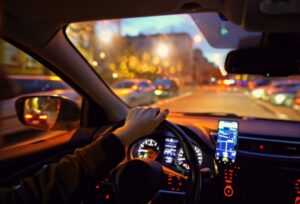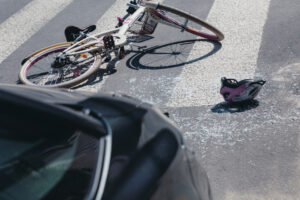Most non-motorcycle riders see lane splitting, lane sharing or lane filtering as a dangerous or even reckless way for motorcycles to navigate through traffic on California roads. In reality, if done safely and prudently, lane splitting can and actually does reduce motorcycle accidents and reduce traffic by reducing the number of vehicles on the road.
So, what is lane splitting and is it legal?
If you’ve encountered a motorcycle driving in your lane with you, or between your car and another car in the next lane, you’ve experienced lane splitting. Lane splitting, also known as lane sharing or filtering, is when a motorcycle goes between lanes or rows of slow-moving or stopped traffic moving in the same direction.
Lane splitting does not necessarily mean that the motorcyclist is riding on the line between the lanes, or the raised pavement markers. Most of the time, even if a motorcycle rider has engaged in lane sharing further up the road, by the time a crash occurs, the rider is probably in control of a lane. The only time a motorcycle rider is actually technically lane splitting is when there is another vehicle on both sides of the motorcycle or if the rider is actually physically sharing a lane with another vehicle.
Many riders will lane split to get out of congested traffic, and then take control of a lane, usually in the left or right wheel track a few feet away from the lane delineators. While a motorcycle rider has control of his or her own lane, this is not lane splitting.
The maneuver is illegal in almost all states and in some states, lane splitting isn’t explicitly forbidden as illegal. Currently, California is the only state where lane splitting is legal in the statutes, not just an activity that is not illegal. If you live in California, or another state where the lane-splitting laws are less, one thing is for certain, motorcyclists should travel between lanes safely and responsibly.
Some may wonder how motorcycles weaving through traffic could possibly make the roadways safer. Motorcycle safety studies have actually shown that lane splitting can remove the motorcycle and rider from dangerous situations. For example, lane filtering reduces the risk of a rider being hit from behind while stopped in traffic. Lane splitting places the motorcycle into a more secure area that is created between two larger vehicles. However, lane splitting tends to get a bad reputation because some riders ignore the rules to do it safely and prudently.
In order to help educate motorcyclists about lane splitting, California Governor Edmund G. Brown, Jr. signed California Assembly Bill 51 in 2016 to define motorcycle lane splitting and to authorize the California Highway Patrol (CHP) to develop educational safety tips.
According to the CHP, lane splitting can be dangerous and extreme caution should be exercised if motorcyclists decide to use these riding techniques. The CHP recommends that lane splitting should not be performed by inexperienced riders, and mentions that the risk of death or serious injury during a lane-splitting collision increases as speed and speed differential increases.
So, how does a motorcycle rider engage in lane splitting safely and prudently? Below are the tips upon which I believe most motorcycle safety experts agree:
Lane Splitting General Safety Tips
The following safety tips can assist motorcyclists when riding, but they are not guaranteed to keep you safe.
- Consider the total environment when you are lane splitting (this includes the width of lanes, the size of surrounding vehicles, as well as current roadway, weather and lighting conditions).
- Danger increases at greater speed differentials (meaning the difference between your bike’s speed and that of the other vehicles you are passing).
- Danger increases as overall speed increases.
- It is typically safer to split between the two far-left lanes than between the other lanes of traffic.
- Try to avoid lane splitting next to large vehicles (big rigs, buses, motorhomes, etc.).
- Riding on the shoulder is illegal; it is not considered lane splitting.
- Be visible. Avoid remaining in the blind spots of other vehicles or lingering between vehicles.
- Help drivers see you by wearing brightly colored/reflective protective gear and using high beams during daylight hours.
- Use your loud pipes or your horn to signal your presence.
Car and Truck Drivers Should Understand Lane Splitting Too
All motorists must take responsibility for sharing the road. Car and truck drivers should also be educated about lane splitting and other ways in which their driving could affect motorcyclists.
Motorists should know that it’s illegal to intentionally block or impede a motorcyclist while driving or even when parked, such as opening a vehicle door into a motorcyclist. The CHP also recommends that vehicles in the far-left lane should move to the left part of the lane so motorcycles have room to pass on their right.
Unfortunately, many motorcycle collisions are caused when other motorists simply do not see the motorcyclist so make sure to check your mirrors and blind spots frequently, especially before changing lanes or making a turn.
It’s important for everyone sharing the roadways to be alert and courteous. If everyone understands the laws and implements safe driving techniques, the roadways will become less dangerous and congested.
For comments, questions, or legal services from an experienced San Francisco motorcycle accident attorney please feel free to call me at 415-432-7290, or visit www.ccwlawyers.com. All calls and email inquiries are covered by the attorney-client privilege and are strictly confidential.

Claude A. Wyle is a partner of Choulos Choulos, and Wyle, a San Francisco based law firm dedicated to representing clients who have been injured by the wrongful conduct of individuals, corporations, public entities, and businesses. Mr. Wyle also frequently sits as a Judge Pro Tem for the city and county of San Francisco.










Comments for this article are closed.